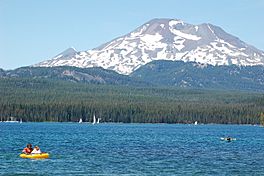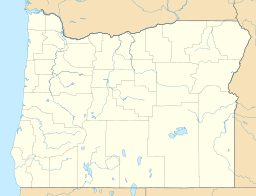Elk Lake (Oregon) facts for kids
Quick facts for kids Elk Lake |
|
|---|---|

The lake with South Sister in the background
|
|
| Location | Deschutes County, Oregon |
| Coordinates | 43°58′27″N 121°48′09″W / 43.97417°N 121.80250°W |
| Lake type | Natural, oligotrophic |
| Primary inflows | Snowmelt, seepage |
| Primary outflows | None on the surface |
| Catchment area | 13 square miles (34 km2) |
| Basin countries | United States |
| Surface area | 405 acres (164 ha) |
| Average depth | 12 feet (3.7 m) |
| Max. depth | 62 feet (19 m) |
| Water volume | 7,000 acre-feet (8.6×106 m3) |
| Residence time | 1 year |
| Shore length1 | 5.1 miles (8.2 km) |
| Surface elevation | 4,882 feet (1,488 m) |
| Settlements | Bend |
| 1 Shore length is not a well-defined measure. | |
Elk Lake is a beautiful natural lake located in the middle of the Cascade Range mountains in Oregon, USA. It sits very high up, almost 4,900 feet (1,494 meters) above sea level. This lake is part of an area shaped by volcanoes. You can find it about 25 miles (40 km) southwest of Bend, right along the scenic Cascade Lakes Scenic Byway.
Elk Lake is also about 6 miles (10 km) west of Mount Bachelor, inside the Deschutes National Forest. Many other lakes are nearby, including Hosmer, Sparks, Blow, Doris, Devils, Lava, and Little Lava.
This lake is very popular for fun activities and is one of the most visited of the Cascade Lakes. It got its name because many elk used to visit the area during the summer. In winter, Elk Lake freezes over, and the roads leading to it are usually closed by snow until late May.
Contents
Fun Activities at Elk Lake
Elk Lake is a great place for outdoor adventures! The United States Forest Service helps manage different areas around the lake. These areas include places to camp, launch boats, and have picnics. There is also a private resort with cabins if you want to stay overnight.
What Can You Do at the Lake?
There are many exciting things to do at Elk Lake:
- Sailing: You can enjoy sailing across the water.
- Motorboating: Motorboats are allowed, making it easy to explore the lake.
- Fishing: The lake is home to different types of fish.
- Swimming: On warm days, you can take a dip in the clear water.
- Windsurfing: If you like watersports, windsurfing is a popular choice.
Fish You Might Catch
The lake has fish like brook trout, which are usually 7 to 14 inches (18 to 36 cm) long. You might also find kokanee, which are a type of salmon, usually around 8 to 9 inches (20 to 23 cm) long.
Hiking Trails Nearby
If you love hiking, there are trails that start at Elk Lake. These trails can lead you to other groups of lakes high up in the mountains, like those in the Mink Lake basin.



